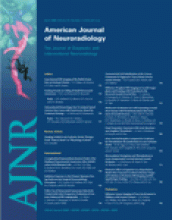Abstract
BACKGROUND AND PURPOSE: A method is presented for high-temporal-resolution MR angiography (MRA) using a combination of undersampling strategies and a high-field (3T) scanner. Currently, the evaluation of cerebrovascular disorders involving arteriovenous shunting or retrograde flow is accomplished with conventional radiographic digital subtraction angiography, because of its high spatial and temporal resolutions. Multiphase MRA could potentially provide the same diagnostic information noninvasively, though this is technically challenging because of the inherent trade-off between signal intensity–to-noise ratio (S/N), spatial resolution, and temporal resolution in MR imaging.
METHODS: Numerical simulations addressed the choice of imaging parameters at 3T to maximize S/N and the data acquisition rate while staying within specific absorption rate limits. The increase in S/N at 3T was verified in vivo. An imaging protocol was developed with S/N, spatial resolution, and temporal resolution suitable for intracranial angiography. Partial Fourier imaging, parallel imaging, and the time-resolved echo-shared acquisition technique (TREAT) were all used to achieve sufficient undersampling.
RESULTS: In 40 volunteers and 10 patients exhibiting arteriovenous malformations or fistulas, intracranial time-resolved contrast-enhanced MRA with high acceleration at high field produced diagnostic-quality images suitable for assessment of pathologies involving arteriovenous shunting or retrograde flow. The technique provided spatial resolution of 1.1 × 1.1 × 2.5 mm and temporal resolution of 2.5 seconds/frame. The combination of several acceleration methods, each with modest acceleration, can provide a high overall acceleration without the artifacts of any one technique becoming too pronounced.
CONCLUSION: By taking advantage of the increased S/N provided by 3T magnets over conventional 1.5T magnets and converting this additional S/N into higher temporal resolution through acceleration strategies, intracranial time-resolved MRA becomes feasible.
- Copyright © American Society of Neuroradiology












